国际市场营销双语共27页
- 格式:ppt
- 大小:3.12 MB
- 文档页数:27
![[精选]国际市场营销学培训讲义英文版](https://uimg.taocdn.com/42479c3153d380eb6294dd88d0d233d4b14e3f00.webp)
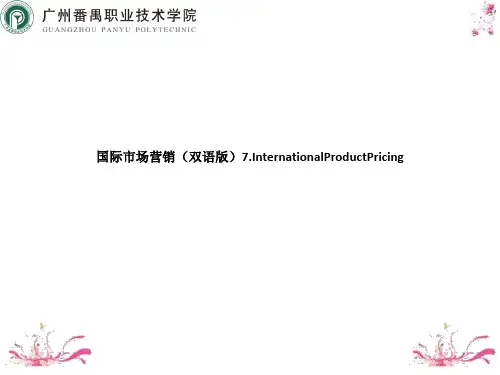
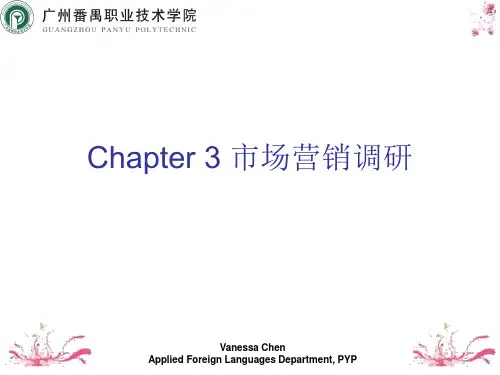

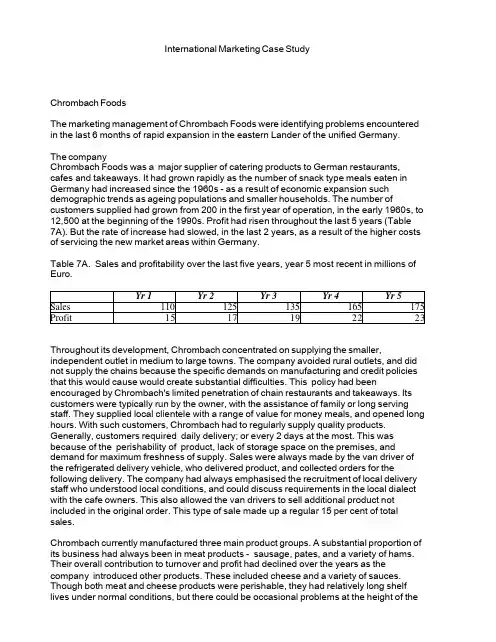
International Marketing Case StudyChrombach FoodsThe marketing management of Chrombach Foods were identifying problems encountered in the last 6 months of rapid expansion in the eastern Lander of the unified Germany.The companyChrombach Foods was a major supplier of catering products to German restaurants, cafes and takeaways. It had grown rapidly as the number of snack type meals eaten in Germany had increased since the 1960s - as a result of economic expansion such demographic trends as ageing populations and smaller households. The number of customers supplied had grown from 200 in the first year of operation, in the early 1960s, to 12,500 at the beginning of the 1990s. Profit had risen throughout the last 5 years (Table7A). But the rate of increase had slowed, in the last 2 years, as a result of the higher costs of servicing the new market areas within Germany.Table 7A. Sales and profitability over the last five years, year 5 most recent in millions of Euro.Yr 1Yr 2Yr 3Yr 4Yr 5 Sales110125135165175 Profit1517192223 Throughout its development, Chrombach concentrated on supplying the smaller, independent outlet in medium to large towns. The company avoided rural outlets, and did not supply the chains because the specific demands on manufacturing and credit policies that this would cause would create substantial difficulties. This policy had been encouraged by Chrombach's limited penetration of chain restaurants and takeaways. Its customers were typically run by the owner, with the assistance of family or long serving staff. They supplied local clientele with a range of value for money meals, and opened long hours. With such customers, Chrombach had to regularly supply quality products. Generally, customers required daily delivery; or every 2 days at the most. This was because of the perishability of product, lack of storage space on the premises, and demand for maximum freshness of supply. Sales were always made by the van driver of the refrigerated delivery vehicle, who delivered product, and collected orders for the following delivery. The company had always emphasised the recruitment of local delivery staff who understood local conditions, and could discuss requirements in the local dialect with the cafe owners. This also allowed the van drivers to sell additional product not included in the original order. This type of sale made up a regular 15 per cent of total sales.Chrombach currently manufactured three main product groups. A substantial proportion of its business had always been in meat products - sausage, pates, and a variety of hams. Their overall contribution to turnover and profit had declined over the years as the company introduced other products. These included cheese and a variety of sauces. Though both meat and cheese products were perishable, they had relatively long shelf lives under normal conditions, but there could be occasional problems at the height of the。
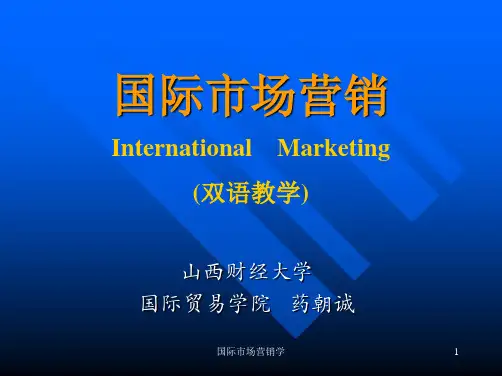
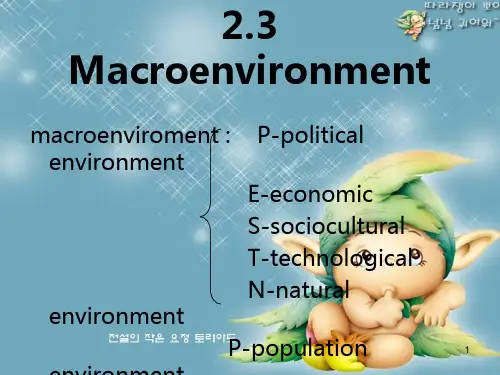
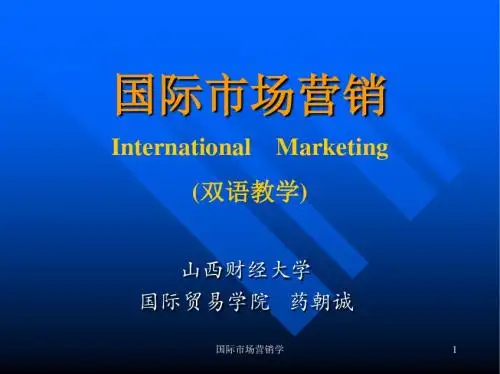
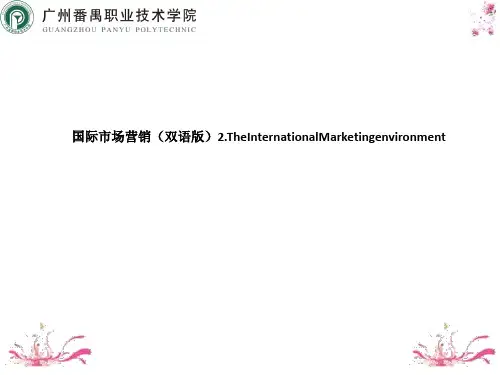
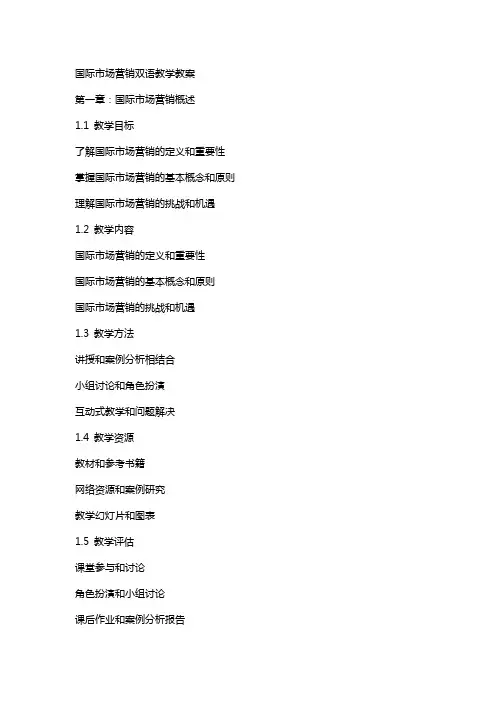
国际市场营销双语教学教案第一章:国际市场营销概述1.1 教学目标了解国际市场营销的定义和重要性掌握国际市场营销的基本概念和原则理解国际市场营销的挑战和机遇1.2 教学内容国际市场营销的定义和重要性国际市场营销的基本概念和原则国际市场营销的挑战和机遇1.3 教学方法讲授和案例分析相结合小组讨论和角色扮演互动式教学和问题解决1.4 教学资源教材和参考书籍网络资源和案例研究教学幻灯片和图表1.5 教学评估课堂参与和讨论角色扮演和小组讨论课后作业和案例分析报告第二章:国际市场营销环境2.1 教学目标了解国际市场营销环境的构成因素掌握国际市场营销环境的变化趋势理解国际市场营销环境的挑战和机遇2.2 教学内容国际市场营销环境的构成因素国际市场营销环境的变化趋势国际市场营销环境的挑战和机遇2.3 教学方法讲授和案例分析相结合小组讨论和角色扮演互动式教学和问题解决2.4 教学资源教材和参考书籍网络资源和案例研究教学幻灯片和图表2.5 教学评估课堂参与和讨论角色扮演和小组讨论课后作业和案例分析报告第三章:国际市场营销战略3.1 教学目标了解国际市场营销战略的制定过程掌握国际市场营销战略的基本要素理解国际市场营销战略的实施和评估3.2 教学内容国际市场营销战略的制定过程国际市场营销战略的基本要素国际市场营销战略的实施和评估3.3 教学方法讲授和案例分析相结合小组讨论和角色扮演互动式教学和问题解决3.4 教学资源教材和参考书籍网络资源和案例研究教学幻灯片和图表3.5 教学评估课堂参与和讨论角色扮演和小组讨论课后作业和案例分析报告第四章:国际市场营销产品策略4.1 教学目标掌握国际市场营销产品策略的基本要素理解国际市场营销产品策略的实施和评估4.2 教学内容国际市场营销产品策略的重要性国际市场营销产品策略的基本要素国际市场营销产品策略的实施和评估4.3 教学方法讲授和案例分析相结合小组讨论和角色扮演互动式教学和问题解决4.4 教学资源教材和参考书籍网络资源和案例研究教学幻灯片和图表4.5 教学评估课堂参与和讨论角色扮演和小组讨论课后作业和案例分析报告第五章:国际市场营销渠道策略5.1 教学目标了解国际市场营销渠道策略的重要性理解国际市场营销渠道策略的实施和评估5.2 教学内容国际市场营销渠道策略的重要性国际市场营销渠道策略的基本要素国际市场营销渠道策略的实施和评估5.3 教学方法讲授和案例分析相结合小组讨论和角色扮演互动式教学和问题解决5.4 教学资源教材和参考书籍网络资源和案例研究教学幻灯片和图表5.5 教学评估课堂参与和讨论角色扮演和小组讨论课后作业和案例分析报告第六章:国际市场营销传播策略6.1 教学目标理解国际市场营销传播策略的基本概念掌握国际市场营销传播策略的制定和实施方法6.2 教学内容国际市场营销传播策略的基本概念国际市场营销传播策略的制定和实施方法国际市场营销传播策略的有效运用6.3 教学方法讲授和案例分析相结合小组讨论和角色扮演互动式教学和问题解决6.4 教学资源教材和参考书籍网络资源和案例研究教学幻灯片和图表6.5 教学评估课堂参与和讨论角色扮演和小组讨论课后作业和案例分析报告第七章:国际市场营销价格策略7.1 教学目标理解国际市场营销价格策略的重要性掌握国际市场营销价格策略的基本要素学习国际市场营销价格策略的制定和评估7.2 教学内容国际市场营销价格策略的重要性国际市场营销价格策略的基本要素国际市场营销价格策略的制定和评估7.3 教学方法讲授和案例分析相结合小组讨论和角色扮演互动式教学和问题解决7.4 教学资源教材和参考书籍网络资源和案例研究教学幻灯片和图表7.5 教学评估课堂参与和讨论角色扮演和小组讨论课后作业和案例分析报告第八章:国际市场营销服务策略8.1 教学目标理解国际市场营销服务策略的基本概念掌握国际市场营销服务策略的制定和实施方法学习国际市场营销服务策略的有效运用8.2 教学内容国际市场营销服务策略的基本概念国际市场营销服务策略的制定和实施方法国际市场营销服务策略的有效运用8.3 教学方法讲授和案例分析相结合小组讨论和角色扮演互动式教学和问题解决8.4 教学资源教材和参考书籍网络资源和案例研究教学幻灯片和图表8.5 教学评估课堂参与和讨论角色扮演和小组讨论课后作业和案例分析报告第九章:国际市场营销风险管理9.1 教学目标理解国际市场营销风险的基本概念掌握国际市场营销风险的识别和管理方法学习国际市场营销风险的有效应对策略9.2 教学内容国际市场营销风险的基本概念国际市场营销风险的识别和管理方法国际市场营销风险的有效应对策略9.3 教学方法讲授和案例分析相结合小组讨论和角色扮演互动式教学和问题解决9.4 教学资源教材和参考书籍网络资源和案例研究教学幻灯片和图表9.5 教学评估课堂参与和讨论角色扮演和小组讨论课后作业和案例分析报告第十章:国际市场营销伦理和社会责任10.1 教学目标理解国际市场营销伦理和社会责任的重要性掌握国际市场营销伦理和社会责任的基本原则学习国际市场营销伦理和社会责任的最佳实践10.2 教学内容国际市场营销伦理和社会责任的重要性国际市场营销伦理和社会责任的基本原则国际市场营销伦理和社会责任的最佳实践10.3 教学方法讲授和案例分析相结合小组讨论和角色扮演互动式教学和问题解决10.4 教学资源教材和参考书籍网络资源和案例研究教学幻灯片和图表10.5 教学评估课堂参与和讨论角色扮演和小组讨论课后作业和案例分析报告重点解析本文档为“国际市场营销双语教学教案”,共包含十个章节。
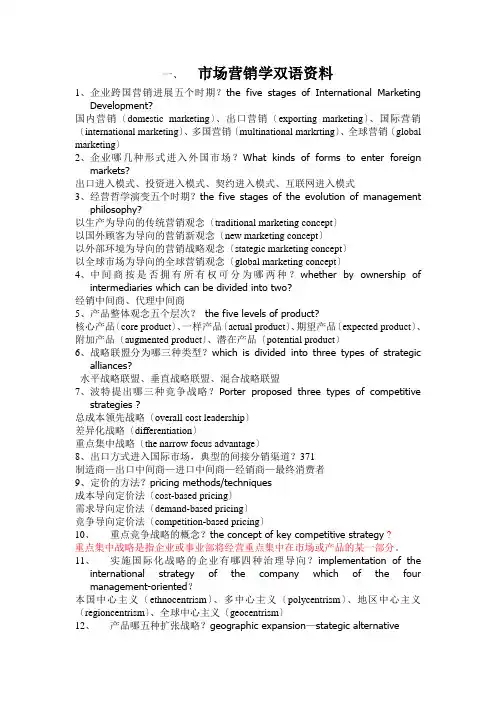
一、市场营销学双语资料1、企业跨国营销进展五个时期?the five stages of International MarketingDevelopment?国内营销〔domestic marketing〕、出口营销〔exporting marketing〕、国际营销〔international marketing〕、多国营销〔multinational markrting〕、全球营销〔global marketing〕2、企业哪几种形式进入外国市场?What kinds of forms to enter foreignmarkets?出口进入模式、投资进入模式、契约进入模式、互联网进入模式3、经营哲学演变五个时期?the five stages of the evolution of managementphilosophy?以生产为导向的传统营销观念〔traditional marketing concept〕以国外顾客为导向的营销新观念〔new marketing concept〕以外部环境为导向的营销战略观念〔stategic marketing concept〕以全球市场为导向的全球营销观念〔global marketing concept〕4、中间商按是否拥有所有权可分为哪两种?whether by ownership ofintermediaries which can be divided into two?经销中间商、代理中间商5、产品整体观念五个层次?the five levels of product?核心产品〔core product〕、一样产品〔actual product〕、期望产品〔expected product〕、附加产品〔augmented product〕、潜在产品〔potential product〕6、战略联盟分为哪三种类型?which is divided into three types of strategicalliances?水平战略联盟、垂直战略联盟、混合战略联盟7、波特提出哪三种竞争战略?Porter proposed three types of competitivestrategies ?总成本领先战略〔overall cost leadership〕差异化战略〔differentiation〕重点集中战略〔the narrow focus advantage〕8、出口方式进入国际市场,典型的间接分销渠道?371制造商—出口中间商—进口中间商—经销商—最终消费者9、定价的方法?pricing methods/techniques成本导向定价法〔cost-based pricing〕需求导向定价法〔demand-based pricing〕竞争导向定价法〔competition-based pricing〕10、重点竞争战略的概念?the concept of key competitive strategy ?重点集中战略是指企业或事业部将经营重点集中在市场或产品的某一部分。
Chapter 1 The Scope and Challenge of International Marketing第一章国际市场营销学的范围和挑战1. MarketingMarketing: the process of building lasting relationships through planning, executing and controlling the conception, pricing, promotion and distribution of ideas, goods and services to create mutual exchange that satisfy individual and organizational needs and objectives.营销是个人和集体通过创造,提供出售,并同他人交换产品和价值,已获得其所需所欲之物的一种社会和管理过程。
Marketing and salesMarketing is the process of seeking to uncover consumers’requirements and adopting the information to product’ distribution and promotion.Sale is to sell what that has already been produced to customers without thinking of the customers’ needs and wants.2. Basic elements of the marketing concept⑴Needs: is a state of deprivation of some basic satisfaction.需求是指没有得到某些基本满足的感受状态。
Physical needs for food, clothing, warmthSocial needs for belonging, respect and affectionIndividual needs for knowledge and self-expression(2)Wants: are devices for specific items that can satisfy those needs.欲望是指对具体满足物的愿望。